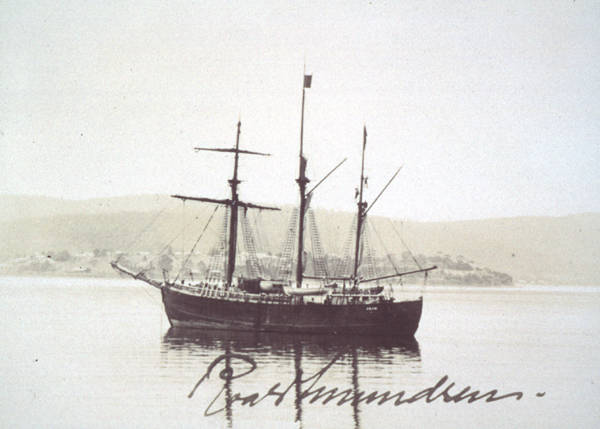 |
 |
|
Antarctica's Links with Tasmania
Antarctica's Links with Tasmania at the beginning of the twenty-first century are many, but were once far more intimate. Some 600 million years ago, and until 55 million years ago, Tasmania was neatly tucked into the coastline of North Victoria Land before plate tectonics broke up the super-continent of Gondwana. James Cook nearly saw the Great South Land. Instructed to explore the south, he crossed the Antarctic Circle three times during 1773 and 1774. He believed that 'no man will ever venture farther south than I have done', but his reports of abundant seals and whales ensured that others would venture further south, and southern Van Diemen's Land provided harbours for American and British sealers and whalers from the 1790s. Hobart's deep-water estuary and southernmost location meant many Antarctic explorers used its harbour. After Captain Biscoe circumnavigated Antarctica in 1831, his two ships struggled to Hobart, their crews ravaged by scurvy. Biscoe was assisted by James Weddell, who discovered the Weddell Sea in 1833, and voyaged farthest south at that time – 74°. The quest for the South Magnetic Pole saw rival expeditions from France and Great Britain in the Derwent between 1839 and 1841, under Dumont d'Urville and Sir James Clark Ross. At the end of the nineteenth century a Tasmanian scientist, Louis Bernacchi, joined the Norwegian Borchgrevink's first over-wintering on the Antarctic continent. The unexpected arrival of Fram in the Derwent in March 1912 caused enormous interest. It carried the Norwegian Roald Amundsen, who had been on an expedition to the South Pole. For days Hobart residents – and the wider world – wondered whether he had beaten Britain's RF Scott to the Pole. After Frank Bowden, Manager of Telegrams at the Post Office, had transmitted Amundsen's dispatch to the King of Norway, the news was finally out that the Norwegians had won the race. By the time of Douglas Mawson's 1911–14 Australasian Antarctic Expedition, Hobart was a well-established departure point for Antarctic exploration, used both by Mawson's expedition – notably by the expedition's ship Aurora, under Captain John King Davis, which left Hobart in 1912 to retrieve Mawson – and in 1914 by the Ross Sea party of Shackleton's planned Imperial Trans-Antarctic Expedition. In 1930 Mawson returned to Hobart to lead his second BANZARE (British, Australian and New Zealand Antarctic Research Expedition) voyage, returning again in 1931. During his visits to Macquarie Island, a dependency of Tasmania, Mawson was appalled by the destruction of its seals and penguins by sealers, who slaughtered indiscriminately. Largely because of his lobbying, the Tasmanian government proclaimed Macquarie Island a sanctuary for wildlife in 1933. Again because of Mawson's efforts, in 1947 the Australian government created ANARE (Australian National Antarctic Research Expeditions) to establish Australia's presence in the Australian Antarctic Territory and islands. Other nations were already active. ANARE did not manage to establish a continental station at Mawson until 1954. The French, voyaging from Hobart from 1948, had established a base on the Terre Adélie coast by 1950. Although the Australian Antarctic Division was based in Melbourne, Hobart was often used as a departure point for ships servicing ANARE stations. In 1981 the Division headquarters moved to Kingston, Tasmania. This move has been influential in the creation of an exponential explosion of Tasmanian Antarctic-related institutions and enterprises. The Division provides transport and logistic support for its four permanent stations, and co-ordinates Australia's Antarctic scientific research programmes. The orange hull of Australia's research and resupply vessel Aurora Australis is a familiar sight, and the French ship Astrolabe is also based in Hobart. Russian icebreakers, converted to tourist cruise ships, are annual visitors. There is increasing international interest in Tasmania as a centre for Antarctic research. The secretariat for the Commission for the Conservation of Antarctic Marine Living Resources was established in Hobart in 1982, to manage the biological resources of the Southern Ocean. Antarctic research expanded at the University of Tasmania following the establishment of IASOS (the Institute of Antarctic and Southern Ocean Studies) in 1988, the Cooperative Research Centre for Antarctica and Southern Ocean (1991–2003) and the CRC for Antarctic Climate and Ecosystems (established 2003). The importance of Tasmania's Antarctic-related enterprises was emphasised by the creation of the Office of Antarctic Affairs (1993), and the Tasmanian Polar Network – an association of industry, government, education and science, which aims to forge closer links between businesses and Antarctic activities. Although tectonic plate action is still remorselessly pushing Tasmania imperceptibly away from Antarctica, efforts are being made to reduce the tyranny of distance, with direct flights from Tasmania to Antarctica planned. Further reading: T Bowden, The silence calling, Sydney, 1997. Tim Bowden
|
Copyright 2006, Centre for Tasmanian Historical Studies |
 ]
]